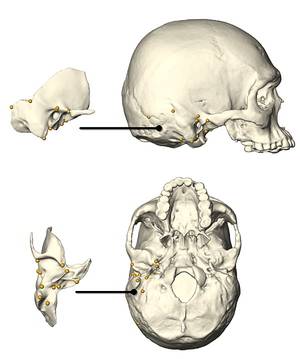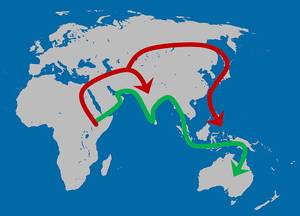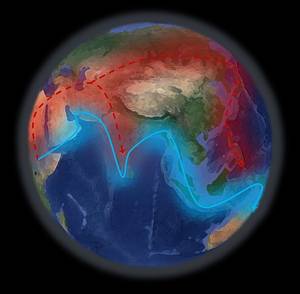Press Releases Archive
21.04.2014
First Eurasians left Africa up to 130,000 years ago
Models tested by Tübingen paleoanthropologists push back the date of first Homo sapiens migration out of Africa
<link internal-link internen link im aktuellen>Spanish Version of the Press Release (starting at 00:00 22.04.2014)
team of researchers led by the University of Tübingen’s Professor Katerina Harvati has shown that anatomically modern humans spread from Africa to Asia and Europe in several migratory movements. The first ancestors of today’s non-African peoples probably took a southern route through the Arabian Peninsula as early as 130,000 years ago, the researchers found. The study is published by Professor Katerina Harvati and her team from the Institute for Archaeological Sciences at the University of Tübingen and the Senckenberg Center for Human Evolution and Palaeoenvironment, in collaboration with colleagues from the University of Ferrara, Italy, and the National Museum of Natural History, France. The study appears in the online Early Edition of the Proceedings of the National Academy of Sciences.
The scientists tested different hypothetical dispersal scenarios, taking into account the geography of potential migration routes, genetic data and cranial comparisons. They found that the first wave of migration out of Africa started earlier than previously thought, taking place as early as the late Middle Pleistocene – with a second dispersal to northern Eurasia following about 50,000 years ago.
Most scientists agree that all humans living today are descended from a common ancestor population which existed 100,000 to 200,000 years ago in Africa. The decreasing genetic and phenotypic diversity observed in humans at increasing distances from Sub-Saharan Africa has often been interpreted as evidence of a single dispersal 50,000 to 75,000 years ago. However, recent genetic, archaeological and palaeoanthropological studies challenge this scenario.
Professor Harvati’s team tested the competing out-of-Africa models of a single dispersal against multiple dispersals of anatomically modern humans. The scientists compared modern human crania from different parts of the world, neutral genetic data, and geographical distances associated with different dispersal routes. Likewise, they reconstructed population split times from both the genetic data and as predicted by each competing model. Because each dispersal scenario is associated with specific geographic and temporal predictions, the researchers were able to test them against the observed neutral biological distances between groups, as revealed from both genetic and cranial data.
“Both lines of evidence – anatomical cranial comparisons as well as genetic data – support a multiple dispersal model,” says Katerina Harvati. The first group of our ancestors left Africa about 130,000 years ago and followed a coastal route through the Arabian Peninsula to Australia and the west Pacific region. “Australian aborigines, Papuans and Melanesians were relatively isolated after the early dispersal along the southern route,” says Hugo Reyes-Centeno, first author of the study and member of the Tübingen team. He adds that other Asian populations appear to be descended from members of a later migratory movement from Africa to northern Eurasia about 50,000 years ago.
The researchers are confident that continued field work and advances in genetics will allow for fine-tuning of models of human expansion out of Africa. So far we can only speculate whether, for example, severe droughts in East Africa occurring between 135,000 and 75,000 years ago prompted migration or had an impact on the local evolution of human populations. The southern route region is a vast geographical space that has been understudied by archaeologists and anthropologists, so future work in this area will help support their findings.
Figures:
All figures: Katerina Harvati/University of Tübingen and Senckenberg Center for Human Evolution and Palaeoenvironment
| Fig. 1 (right): Landmarks shown in one individual cranium. In addition to genetic sequence data, information on cranial shape was used to infer modern human migration patterns. Data was collected and analyzed using innovative techniques. |  |
 | Fig. 2 (left): Landmarks of the temporal bone shown in one individual. The temporal bone has been shown to reflect modern human population history better than other parts of the cranium. It was therefore used in this study to infer migration patterns, in addition to genetic data. Shown here is the mean temporal bone shape of all individuals in the study. |
 |  |
Fig. 3 and 4: The Out-of-Africa model that best fits both the genetic and cranial shape data. A first migration along the Indian Ocean rim occurred as early as 130 thousand years ago (green or blue arrow) and was followed by a second, more recent migration wave into Eurasia (red arrow). | |
Publication:
Hugo Reyes-Centeno, Silvia Ghirotto, Florent Détroit, Dominique Grimaud-Hervé, Guido Barbujani, Katerina Harvati: Genomic and Cranial Phenotype Data Support Multiple Modern Human Dispersals from Africa and a Southern Route into Asia. Proceedings of the National Academy of Sciences, online Early Edition in the week of April 21, 2014.
Contact:
Prof. Dr. Katerina Harvati
University of Tübingen – Institute for Archaeological Sciences
Senckenberg Center for Human Evolution and Palaeoenvironment
Phone +49 7071 29-76516
<link mail>katerina.harvati[at]ifu.uni-tuebingen.de
<link internal-link internen link im aktuellen>Spanish Version of the Press Release (starting at 00:00 22.04.2014)
The University of Tübingen
Innovative.Interdisciplinary.International.Since 1477. These have always been the University of Tübingen’s guiding principles in research and teaching. With its long tradition, Tübingen is one of Germany’s most respected universities. Tübingen’s Neuroscience Excellence Cluster, Empirical Education Research Graduate School and institutional strategy are backed by the German government’s Excellence Initiative, making Tübingen one of eleven German universities with the title of excellence. Tübingen is also home to six Collaborative Research Centers, participates in four Transregional Collaborative Research Centers, and hosts six Graduate Schools.
Our core research areas include: integrative neuroscience, clinical imaging, translational immunology and cancer research, microbiology and infection research, biochemistry and pharmaceuticals research, the molecular biology of plants, geo-environment research, astro- and elementary particle physics, quantum physics and nanotechnology, archeology and prehistory, history, religion and culture, language and cognition, media and education research.
The excellence of our research provides optimal conditions for students and academics from all over the world. 28,500 students are currently enrolled at the University of Tübingen. As a comprehensive research University, we offer more than 250 subjects. Our courses combine teaching and research, promoting a deeper understanding of the material while encouraging students to share their own knowledge and ideas. This philosophy gives Tübingen students strength and confidence in their fields and a solid foundation for interdisciplinary research.
Senckenberg Nature Research Society (Senckenberg Gesellschaft für Naturforschung)
To study and understand nature with its limitless diversity of living creatures and to preserve and manage it in a sustainable fashion as the basis of life for future generations – this has been the goal of the Senckenberg Nature Research Society (Senckenberg Gesellschaft für Naturforschung) for almost 200 years. Through its exhibits and museums Senckenberg showcases and shares the current results of its natural history research with the public and offers insights into the past and present changes in nature, their causes and effects. Additional information is available at <link http: www.senckenberg.de>www.senckenberg.de.
